Bureaucracy & Organizational Politics
Emergent Characteristics of Structure
It has been said that, "Organizations are perfectly designed
and operated to produce the results they get." Yet, do they
get the results they want? Not usually! Have you, as I, puzzled
over this to the point utter frustration, without feeling that
you had found an appropriate understanding? The following represents
a developing set of thoughts as to why organizational design implies
the results the organization gets, along with some thoughts regarding
alternatives. This article is somewhat an outgrowth of ideas initially
developed in Leadership and Management:
A Structural Perspective.
Is organizational design limited to traditional thoughts about
hierarchy and reporting relationships, or does it encompass more,
much more? Are not the organization's policies, procedures, incentives,
rewards, goals, management assumptions, conclusions, beliefs,
and actions all part of what influences the activities of an organization?
Is not the trust employees have for those they work for, how they
feel about their work, and how they feel about each other part
of the structure of the organization? A structure which has an
affect on how things are done, and what is accomplished.
Buckminster Fuller said that rather than attempting to teach people
the right things to do, one should design organizations such that
doing the right things was simply the path of least resistance.
When all the relevant elements of organizational design are considered
this seems an appropriate perspective.
Is it the management of an organization which is most desired,
or is it the production of results? Traditionally organizations
have been designed in a hierarchical fashion because they are
easier to manage, or so it is most commonly believed. Suppose
the hierarchical structure makes an organization neither easier
to manage, nor more results oriented. How would we know? Suppose
one could design an organization that was essentially self-managing.
Probably a heretical thought from management's perspective, for
then what would be management's purpose.
In response to this question, consider for a moment, a ship, if
you will, and ask which function aboard the ship is the most important?
Is it the Captain, who is responsible for running the ship? Is
it the Navigator, who is responsible for plotting the course?
Is it the Engineer, who is responsible for ensuring that the ship
has the power to follow its course? Or is it none of these? Who
really has the greatest influence over the operation of the ship?
Is it not the designer who initially designs the ship to be built?
Is it not the design of the organization, rather than its ongoing
operation, which is the most important responsibility of management.
Organizations consist of two types of functions with different,
yet similar intents. There are those processes which begin and
end with an external customer interaction, and have relatively
easily measurable results. Then there are those functions which
are process enablers. Process enabler functions do not begin and
end with external customer interaction, but support those processes
which do. These functions generally have results which tend to
be more subjective than objective, and are more difficult to measure.
With the above consideration an organization may be viewed as
per the following diagram.
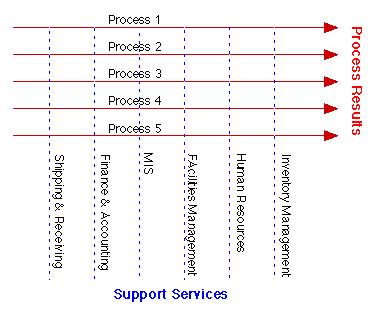
This diagram is not intended to imply that all the functions
identified as processes need to exist as separate processes, but
more to point out that within the organization there are various
end to end processes which are operational. The relevant question
is whether or not there are more advantages than disadvantages
to be gained from combining processes. Everything has an up-side
and a down-side.
Note that Customer Service exists as a function for which it is
difficult to determine whether it is really a process or a support
service. I have decided to consider it as a process because it
begins and ends with an external customer interaction, mostly.
Yet, unlike most processes, it is one the organization should
seek to leverage rather than minimize. There will be more about
this later.
The above diagram essentially represents what is generally termed
a matrix organization, and organizational theorists have long
since agreed that matrix organizations generally don't work as
well as expected. Yet, I have never seen a really good explanation
as to why this is. It is my opinion that the reason matrix organizations
don't work as expected is that they are only partially implemented,
and essentially doomed to failure before they begin, because of
this partial implementation.
The above processes exists within the current organization, within
the context of the hierarchical reporting structure. They're just
not treated as processes proper. The appropriate manner in which
to do this will be addressed shortly.
The activity within most organizations generally looks more like
Diagram A than like Diagram B. And the reason has everything to
do with the design of the organization. This is true even in matrix
organizations that treat some of their functions as processes.
The following paragraphs will describe how to design an organization
to produce what is represented in Diagram B, not how to get from
Diagram A to Diagram B. This may be a little counter-intuitive
at first because Diagram A is essentially what exists.
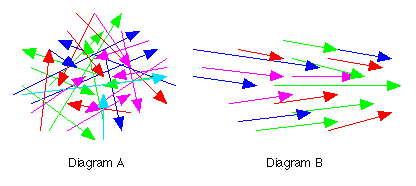
The reason for proceeding in this fashion is that organizations
are systems, and the first rule of systems is "Don't fight
the system. Change the rules and the system will change itself!"
This is very closely related to Buckminster Fuller's comment at
the beginning of this paper.
Rather than analyze the matrix structure presented above, the
following will essentially be a synthesis of a systemic operation
which promotes the desired results. To accomplish this it is essential
that we first understand the way hierarchical organizations are.
We begin with "A Process," which is representative of
any of the processes labeled above.

A process may consist of any number of functions, three was
simply chosen as some representative number. The whole intent
and purpose of the process is to optimize throughput. That is,
to generate the highest possible levels of customer satisfaction
with the least amount of resource in the shortest amount of time.
Because we don't believe the functions (f1, f2, f3) can operate
as autonomous self-managed groups we assign supervisors, which
report to some level of upper management and make them responsible
for the functions. Responsible for seeing that the work gets done.
Thus the structure begins to look a bit different.
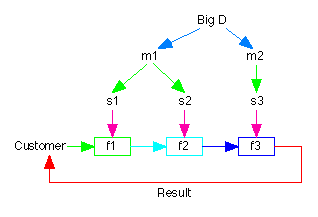
This begins to create all sorts of difficulties. The first
problem has to with a false belief, because you don't optimize
the system by optimizing the components of the system. The interactions
between the components of the system are as relevant, if not more
relevant, to optimization than the functions, but we'll get to
that later.
Supervisors are supposedly responsible for ensuring the work gets
done, yet they are more apt to be loyal to pleasing their management,
because that's were their performance appraisals are done. And
we shouldn't make the misguided assumption that ensuring the work
gets done is what places supervisors in a favorable light with
their manager. Let's be real, annoying as it might be.
And the situation is coerced even more because managers report
to some higher level of management, here labeled Big D, and they
operate in a manner similar to that described for supervisors,
regardless of how much they would like to deny the fact. One generally
responds favorably to the hand that feeds them.
So who's responsible for the process? Only Big D! And what real
influence does Big D really have on the process? Think about pushing
on a rope. Also refer to Leadership
and Management: A Structural Perspective.
Now if this situation wasn't bad enough as presented, realize
that the process does not have the capacity to complete the result
for which it is responsible without the assistance from some number
of support functions, i.e. one or more of the Support Services
identified in the initial diagram. In its simplest form this migrates
the structure to look rather like the following.
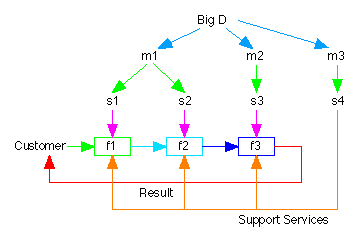
Note that "s4" actually represents multiple supervisors
for multiple Support Services and "m3" represents multiple
managers. "m3" and "s4" are responsible for
providing support to the the individual functions of the process,
actually multiple processes. Yet, the multiple supervisors are
in competition with each other to serve their manager, and "m3"
representing multiple managers, is in competition with "m1"
and "m2" in relation to Big D. This additional complexity
only implies that Big D has even less direct influence over the
process than if the Support Services didn't exist.
Now that you're probably quite thoroughly depressed, you ask,
how do we get out of this mess? Just wait, it gets worse!
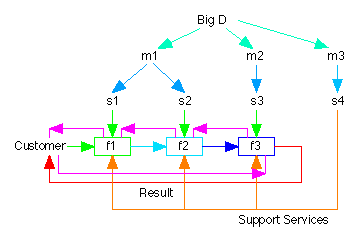
The next attempt was Total Quality Management, where each group
begins to pay attention to the requirements of its customer. Notice
the addition of but 4 more arrows to the above diagram. Probably
the single greatest reason for the failure of TQM was that it
never did anything to change the structure of the environment.
The reporting relationships and loyalties remained the same and
sooner or later undermined any progress that TQM could make. It
also didn't help that TQM has a tendency to produce a very localized
myopic focus on the immediate customer as opposed to the whole
process or the whole organization, and this gets back to the previous
statement about not being able to optimize the process by optimizing
the parts.
Over the past few years there has been an extensive amount of
work done in the area of semi-autonomous Teams or self-managing
work groups. Although there have been numerous successes in this
arena, there have been just as many failures. Again, the basis
for these failures stems primarily from the fact that the overall
structure of the system was not addressed and changed. In addition
to this, self-managing work groups are often pursued with confusing
messages which undermine their potential success. One of the most
prevalent of these mixed messages comes from management continuing
to talk about the benefits of a team based operation, while still
performing individual performance appraisals. The individual performance
appraisal tends to refocus individuals on individual performance
rather than team performance.
In the midst of all this one has to deal with bureaucracy and
organizational politics. And although everyone decries their existence
few have ever figured out how to rid the organization of them.
The reason bureaucracy and organizational politics flourish is
that they are a natural emergent quality of the organization structure
discussed to this point. One of the first principles of systems
is that "structure influences behavior" and the traditional
organization structure promotes the development of bureaucracy
and organizational politics. This along with the realization that
people always, always, always do exactly what makes the most sense
to them at the time they do it, implies that the only way to overcome
these organizational dysfunctions is to alter the structure in
such a way that bureaucracy and organizational politics simply
produce no advantage.
Reengineering is the first management fad to even come close to
addressing the root of the problem, without ever quite realizing
that it was the root of the problem that was being addresses.
Probably the most comprehensive approach to reengineering I've
seen to date, with conscious foundation, is something called Whole
Systems Architecture, which was developed by Dr. Lawrence Miller
at Miller Consulting in Atlanta, GA. Dr. Miller was also the author
of "Barbarians to Bureaucrats" in the late 1980s. The
idea being that if you wish to produce lasting change within an
organization you have to change the structure, not just the organization's
reporting structure, e.g. the blocks on the organization chart.
You have to change all the pieces which represent the real structure,
i.e. the processes, policies, procedures, incentives, rewards,
management philosophy, etc. This is very much in line with another
foundational principal of systems, "Don't fight the system,
change the rules and the system will change itself." This
comment is directed at all those elements mentioned above which
are part of the rules of the system. The structure and the rules
are one!
Reengineering, in most instances, is a relatively inappropriate
label to be applied to the activities undertaken, for how can
you reengineer something that wasn't engineered in the first place?
Organizations are for the most part not engineered, they just
develop out of apparent necessity over time, from one anomaly
to the next. Whenever something develops within the organization
that doesn't fit within the current structure, or mode of operation,
the operation is altered just enough to accommodate that new something.
In this way the organization develops, or evolves, over time,
very much on an as needed basis.
From this point we go back to the beginning and define a more
appropriate architecture beginning with the fundamental unit of
the organization, the process.

The intent of the process is to produce a result for the customer
in a manner which satisfies the customer's expectations and makes
money for the organization. Without getting into the eternal argument
regarding profit as "the motive" of the organization,
let me simply put it that profit is a requirement for doing business,
not the objective. This is much like breathing is a requirement
of living, but not its objective. If profit is the ultimate objective
of a business then the business should sell drugs, for this business
has a much higher return on investment.
For a multi-function process to produce the appropriate result
each function must focus on its operation and the results of the
process. The operative word here is "AND." The functions
should be setup as self-managing work groups which are evaluated
on their contribution to the process. This creates a balance where
a function cannot succeed if the process fails. This requires
that each function receive continuing feedback on how the whole
process is operating, and the results produced, as well as the
progress of each function in the process. The process is evaluated
on the results of the process.
With the establishment of self-managing workgroups there is a
point which is often confused, and for good reason. The point
of confusion has to do with the difference between importance
and value. If each member of a self-managing work group is equally
important, then why are they not all paid the same. While each
member of the group is equally important, they are not equally
valuable. The value of a member of the group has to do with the
replaceability of the skill the individual brings to the group.
And replaceability is dependent on the availability of individuals
with that skill, the length of time that it takes to develop that
skill, and the level of expertise of that individual in that skill
area. While a surgeons assistant and a surgeon are equally important
to the success of the operation, it takes far longer to develop
the expertise of the surgeon than the assistant.
As an organization transitions from the traditional supervisor-employee
relation to self-managed teams the individual teams need ongoing
support of their development. To provide this support I have contemplated
a position called Senior Associate.
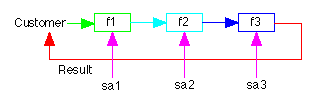
The Senior Associate is not intended to fill the traditional
supervisor role, but rather act as a resource to the function,
responsible for providing development support services. That is
to say, the Senior Associate essentially acts as a consultant
to the function, with the Senior Associates performance evaluated
by the function, not some other level of management. This will
tend to keep the Senior Associate's attention focused on the function
to be supported as opposed to developing allegiances with management.
Another position considered is that of Process Coordinator. This
individual is responsible for the results of the process, the
development of Senior Associates, and development and performance
of the process functions.
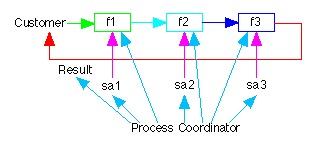
Again, the Process Coordinator position is not responsible
for the traditional management functions of planning, organizing,
directing, and controlling. This individual is responsible for
delivering services to the Senior Associates, and the process
functions. The performance of this individual is evaluated based
on the results of the process, and the perceptions of the Senior
Associates, as well as the self-managed teams. You might say this
person reports to everyone in the process, including the Customer.
This still leaves the question of Support Services and how to
overcome the limitations inherent in the traditional structure
for managing and providing support services.
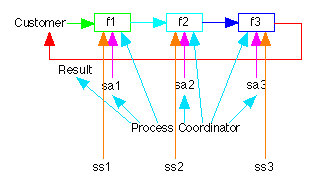
The above diagram depicts three different support services
provided to the functions, yet it is recognized that the same
service may be provided to multiple functions, and multiple services
may be required by different functions.
In order to remove the previously described difficulties with
support services reporting to some position in the organizational
hierarchy, support services must report to and be evaluated by
the functions they support. This solves one part of the problem,
yet creates another. That is, if the support provided enhances
the function's operation and the results of the process, and there
is no cost associated with using services, then the functions
will demand as much support as they can get. As long as it's free,
I want all I can get.
To overcome this the individual functions, and the process they
are part of, are assessed a cost for using support services. In
this way support services desired and used is balanced because
using services detracts from the results produced by the process.
The situation becomes results oriented self-limiting rather than
management limited.
In the same fashion that there are Senior Associates and Process
Coordinators responsible for, and reporting to, the processes
and their components, there are Senior Associates and Services
Coordinators responsible for, and reporting to, the service operations.
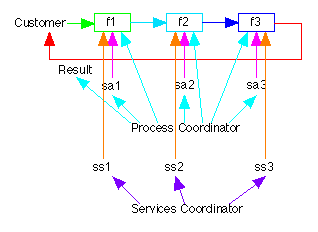
Service Coordinators, Process Coordinators, and upper management,
then act in a collaborative fashion to continue to evolve the
design of the organization, which has essentially become a completely
self-directed, self-evaluating, self-managing, results oriented
structure. One of the primary values added by the Senior Associates
and Coordinators is a breadth of awareness and the time horizon
they consider. The self-directed functional teams have a primary
focus on their operation, in a short term time frame, with an
awareness of the process. Senior Associates are more aware of
the interactions between functions and service providers, and
consider time frames of weeks and months. Coordinators should
have an even broader perspective on whole processes, and consider
time frames of months and years.
The relevant question at this point then becomes how to get from
the current operational environment to the envisioned future operation.
And this isn't nearly as difficult as it might at first seem.
The traditional approach to organizational change of this scope
has been to get top management to buy in, then attempt to communicate
and energize the whole organization to the transformation. I have
seen this method applied in numerous TQM implementations, more
often than not with an ensuing dismal failure. Attempting to transform
the whole organization at once simply dilutes the effort, and
since organizations have experienced numerous attempts at transformation
in the past, they have become essentially numb to intervention.
The most appropriate approach to organizational transformation
is one rule (read structure) at a time. As was previously stated,
structure influences behavior, and the policies, procedures, incentives,
rewards, etc. are all elements of the structure. They are the
rules of the operation. They are the structure! To change the
operation of the organization, change the rules, one at a time,
and the organization will change itself in response. A bit more
clarification is in order at this point.
As for the transformation of the various segments of the organization,
this should be on a group by group basis. That is, work with a
single organization, introduce a set of concepts, develop an understanding,
and then work with the group so they can actually develop their
own transformation plan. It would be quite easy to develop the
plans for them, but then it would have to be sold to them, and
it would always be someone else's plan, not theirs, and probably
the best you could hope for would be enrollment rather than commitment.
Having considered this at some length it would seem most appropriate
to work with the process organizations first and then progress
to the support services groups. It should also be remembered that
in the beginning small wins produce great long term returns.
This does not imply that one group is finished before the next
group begins. It implies that one begins one group at a time.
As a group becomes more capable of functioning on its own then
proceed to the next group, and then the next. This is an endeavor
which does not actually have an end, for the development of the
individual groups, and the organization, is a process in and of
itself, which should continue for the life of the organization.
The transformation represents embarking on a journey, not pursuing
a specific objective destination.
As far as concepts introduced and transformation plans developed
everything is done from a basis of what gets measured. That is,
first develop an understanding of what it makes sense to measure,
and then support the development of the group to effectively produce
those measures. This is true for both support services and processes,
realizing that processes will have a tendency to be somewhat more
objective while the support services will tend to be somewhat
more subjective. Yet, both are quite measurable. If you can't
measure it, why do it?
In the development of an understanding of what is most meaningful
to measure, and how to measure it, it is essential to keep in
mind that measurements must include the Voice of the Customer,
the Voice of the Employee, and the Voice of the Business. All
three dimensions must be accommodated.
It is understood that extensive support must be available to assist
the individual groups during their transformation. And, at the
same time, remember this must be a level of support that nurtures,
supports, coaches, etc., rather than drive the group toward a
destination. This type of support must also be available to assist
in the development of Senior Associates and Process/Service Coordinators.
As for a specific point to begin with a group, it begins with
a single question, "Are there ways that our efforts could
be made more meaningful." This is not a question directed
toward making things faster, less expensive, etc. These will be
beneficial outcomes of the effort. The meaningful questions for
the group in addition to the initial question are:
- What is the group doing that it should continue doing?
- What is the group doing that it should improve in some way?
- What is the group not doing that it should begin doing?
- What is the group doing that it should stop doing?
Just Do It!
When I had reached this point I thought I was pretty much done.
Then someone said, "Ok. You have the job. Now tell me exactly
how you're going to make it a happen."
Partly it's a good question and partly it's a terrible question.
As for the good part, additional thought about specific actions
to be taken is a good idea. From the bad part, it's actually two
parts. This whole description isn't something one makes happen.
It's something one enables to happen! The other part has to do
with advantages and disadvantages of explicit descriptions of
how to do things.
Fads become fads when we reduce foundational understanding to
regimented formulas which are essentially followed without much
conscious thought. A formula for multiplying two numbers is fine
because the same formula always works. In an organizational context
there are simply to many variables for any formula to be correct.
The foundation of action must be understanding tempered with continued
reevaluation of the current situation. Anything less has a very
high probability of failure.
So back to the question of an explicit sequence of steps to be
taken to get from here to there, and here is a initial stab at
it. This is not intended to be "the answer" but more
a set of guidelines from which specific approaches would be developed
by individuals responsible for various facets of implementation.
In a number of places there have been comments about alignment,
and alignment can only happen when there is something to align
upon. A laser aligns because it is focused via a lens. In this
instance the focal point is initially created by a paper entitled
"This I Believe," which whoever is responsible for the
organization needs to write. This is a one page statement of belief
which talks to what is believed about people, customers, and the
business. This should be very consistent with the Voice of the
Employee, Voice of the Customer, and Voice of the Business dimensions
previously presented. Once written the paper needs to be shared
with the organization and then the author must continually act
in a manner consistent with what has been written. What this does
is create a focal point for alignment along with a continuing
set of actions consistent with what was written, thus serving
as an example of coherence.
The next step is to transform one group within the organization,
with the intent of this group later serving as a model to the
rest of the organization. A model which can be presented from
the perspective of saying, "See, it can be done. Here is
an example!"
The intent is to develop a sense of ownership within the group
from the perspective that the group feels responsible for their
own actions and the direction in which those actions are taking
the group. It is proposed that this be accomplished from the one,
to the many, to the all. What this implies is beginning the transformation
on the individual level, progressing to small groups, and finally
to the whole group, in such a manner that the whole group essentially
feels like, and believes, they were themselves responsible for
the transformation.
I would begin this by meeting with each individual in the group,
one on one, and use the following set of questions as a basis
for discussion.
- Why are we here?
- What is the group doing that it should continue doing?
- What is the group doing that it should improve in some way?
- What is the group not doing that it should begin doing?
- What is the group doing that it should stop doing?
- What do you expect from me?
- What do I have a right to expect from you?
During these meetings the intent is essentially to create an
expectation on the part of the individual that their perspectives
are valuable, and that something will be done with their input.
There must be no attempt to debate each individuals perceptions.
At this point knowing and the creation of expectations is the
most important part of this activity. I would ask questions for
clarifications where I wasn't quite clear as to the implications
of the answer. I would probably also ask questions regarding areas
that weren't touched on by the initial set of answers. Areas which
might include what does it make sense to measure, and how do we
measure it, how should the group operate, and how should it evaluate
it's own operation, how should performance appraisals be done,
etc. As I met with each individual I would keep a set of notes
as to the answers provided in each category.
After meeting with each individual I would have them start meeting
in small groups of 4 to 6 people to discuss the collective set
of answers developed during the individual meetings. Were I the
individual responsible for this group (a reference to a prior
mode of operation that has to be done away with) I would have
this meeting facilitated by someone else so I did not tend to
hamper communications among the individuals. The intent would
be to have them develop some consensus as to the most important
entries in each category and determine to what extent the answers
in the "Why are we here?" category are consistent with
the previously written "This I Believe Statement."
These meetings actually accomplish two things, one obvious, one
not so obvious. The meetings provide a focus for groups of people
to come together on something other than themselves, and their
personal differences. Providing this point of focus allows the
group to come closer together without realizing it. The meetings
also end up producing relatively prioritized lists of purpose,
vision, values, and actions to be taken. The purpose, vision,
values, and actions which emerge from this interaction are something
you couldn't get by directly asking for purpose, vision, values,
and actions. Some things just don't work the way we would expect
them to work.
Once the small group meetings have been completed the small groups
findings must be collectively presented to the whole group, by
different members of the individual groups, and the whole collective
must come to some sort of agreed upon consensus as to "What's
to do?" At this point I should realize full well that the
actions required will be in two categories, those which can be
done by the group, and those which must be done by groups at other
locations within the organization.
The group essentially develops it own set of marching orders at
this point, and individuals from within the group should be allowed
to take the lead on various items. And, the individuals that take
the lead would be responsible for reporting back to the group
regarding progress in certain areas. This is rather the development
of team based self-managed work groups without ever telling anyone
that it's being done. It's something you just allow them to get
to because it's where they will gravitate to when allowed to do
so.
As for the support efforts which are identified as responsibilities
of other places in the organization, this support is very critical,
and must happen, for if the support doesn't happen it will discourage
the group.
At this point, as the group accepts responsibility for itself
I would make it know that I am a resource at their disposal for
certain types of support which they deem most appropriate. I am
not there to do their job, but I am there to provide support.
All of the traditional management / supervisor responsibilities,
i.e. planning, organization, directing, and controlling, have
been transferred to the group. My primary role would be one of
facilitator, coach, and coordinator for things the group asked
that I coordinate. At this point I would expect that my performance
feedback would be done by the group for it is they who are now
my customers, not the management I used to report to.
In conjunction with all of this, there is an awareness that "Senior
Associates" need to be developed, and at present there is
no model for them to follow, because no Senior Associate currently
exists. So what's to do?
The first Senior Associate is being developed on the fly during
this process. And before the effort was started it would seem
to make sense to identify the next couple of potential transformation
groups and have them become familiar with the process as it unfolds.
The intent is for them to develop an understanding by association.
This would make the whole process somewhat familiar to them when
they began the same effort. At some point along the way it is
expected that individuals that have been acting as Senior Associates
could begin to act as facilitators for the later transformation
groups.
In the midst of all this, upper management begins to get out of
the day to day running of the operation and begins to develop
a longer term perspective on the overall design of the organization,
as was previously discussed. This would be accomplished via the
same process as described for individual group transformation,
with the same set of questions. The responses to which would be
distilled and prioritized during group meetings to develop consensus.
And I guess at this point I would say, "And that is that!"
theWay of Systems
* Feedback
* Musings
Copyright © 2004 Gene Bellinger
|